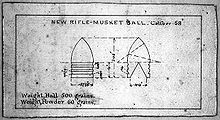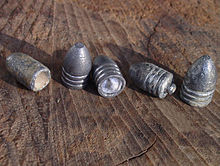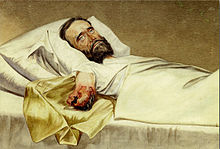- Minié ball
-
 1855 minie ball design from Harpers Ferry, West Virginia.
1855 minie ball design from Harpers Ferry, West Virginia.
The Minié ball (or minie ball) is a type of muzzle-loading spin-stabilising rifle bullet named after its co-developer, Claude-Étienne Minié, inventor of the Minié rifle. It came to prominence in the Crimean War and American Civil War.
Contents
Design
The Minié ball was a conical-cylindrical soft lead bullet, slightly smaller than the intended firearm barrel's bore, with (originally) four exterior grease-filled grooves and a conical hollow in its base. The bullet was designed by Minié with a small iron plug and a lead skirting. Its intended purpose was to expand under the pressure and obturate the barrel and increase muzzle velocity.
The precursor to the Minié ball was created in 1848 by the French Army captains Montgomery and Henri-Gustave Delvigne. Their design was made to allow rapid muzzle loading of rifles, an innovation that brought about the widespread use of the rifle as a mass battlefield weapon. Delvigne had invented a ball that could expand upon ramming to fit the grooves of a rifle in 1826.[1] The design of the ball had been proposed in 1832 as the cylindro-conoidal bullet by Captain John Norton,[2] but had not been adopted.
Usage
The bullet could be quickly removed from the paper cartridge with the gunpowder poured down the barrel and the bullet pressed past the muzzle rifling and any detritus from prior shots. It was then rammed home with the ramrod, which ensured that the charge was packed and the hollow base was filled with powder. When fired, the expanding gas pushed forcibly on the base of the bullet, deforming it to engage the rifling. This provided spin for accuracy, a better seal for consistent velocity and longer range, and cleaning of barrel detritus.
History
The Minié ball only saw limited distribution in the Crimean War but later Minié-derived weapons were the most common firearm in the American Civil War. The adoption of this ammunition allowed soldiers to reload their rifled muskets faster and fire them more accurately. This increased the lethality of weapons used on the battlefield and effectively rendered conventional line infantry tactics obsolete.
The increased range and accuracy of the Minié ball was a major factor in the defeat of the Russians in all of the early battles of the Crimean War. The Russians had antiquated muskets, with a range of 300 paces; the British and French could fire accurately from four times that range and hence could avoid close combat. [3]
The government of the United States adopted the Minié ball before the Civil War, with some changes. The skirt of the bullet base was made slightly thinner and the plug was omitted, as the pressure of the powder gas alone was sufficient to expand the skirt to engage the rifling. Also, as adopted by the U.S. government, only three exterior grease-filled grooves were used, instead of four.
Like the musket ball, the Minié ball produced terrible wounds on those struck in battle. The large-caliber rounds easily shattered bones, and in many cases the attending surgeon simply amputated the limb rather than risk a typically fatal secondary infection. Due to the increased accuracy of rifled muskets firing these rounds, the American Civil War and to a lesser extent the Crimean War resulted in mass casualties on a larger scale than any previous conflicts.[citation needed]
Notes
- ^ Sam Fadala (2006). The Complete Black Powder Handbook: The Latest Guns and Gear (5th ed.). Gun Digest Books. p. 144. http://books.google.com/books?id=Dzxyneq43AEC&pg=PA144&dq=Delvigne+Minie#PPA144,M1. Retrieved 2010-05-14.
- ^ Robert L. O'Connell (1990). Of Arms and Men: A History of War, Weapons, and Aggression. Oxford University Press US. p. 191. http://books.google.com/books?id=6Y8CNoQqSywC&pg=RA1-PA191&dq=Captain+Norton+Minie+1832#PRA1-PA191,M1. Retrieved 2010-05-14.
- ^ Orlando Figes (2010). The Crimean War: A History. Metropolitan Books US. p. 215. http://books.google.com/books?id=dimVhWPx_88C. Retrieved 2011-08-104.
Muskets, which were smoothbore, were only accurate to 50 paces, i.e., 50 yards, not 300 paces (yards). Rifles, such as the Baker rifle used by the British rifle regiments during the Napoleonic Wars could fire accurately to 150 or 200 yards. My understanding of the Civil War rifles using the minnie ball was that were routinely used at distances of 300 yards.
References
- Brent Nosworthy (2003). The Bloody Crucible of Courage, Fighting Methods and Combat Experience of the Civil War. Carroll and Graf Publishers. ISBN 0-7867-1147-7.
- "The lead minie ball". CivilWar@Smithsonian. http://www.civilwar.si.edu/weapons_minieball.html.
Small arms Charleville musket · Delvigne rifle (1826) · Thouvenin Carabine à tige (1846) · Lefaucheux M1858 revolver · Minié rifle (1849) · Tabatière rifle (1864) · Chassepot rifle (1866) · Gras rifle (1874) · Lebel rifle (1886) · Modèle 1892 revolver





Machine guns Cannons Year XI system (1803) · Paixhans gun (1823) · Valée system (1828) · Canon obusier de 12 (1853) · La Hitte system (1858) · de Reffye system (1870) · Lahitolle 95 mm (1873) · de Bange system (1875) · Canet 320 mm (1880) · Canon de 75 (1897)
Warships Ammunition Lepage fulminate (1807-10) · Pauly-Prélat integrated cartridge (1808) · Prélat percusion cap (1818) · Lefaucheux cartridge (1836) · Tamisier ball (1841) · Minié ball (1847) · 8 mm Lebel smokeless powder cartridge (1886)
Systems Lepage percussion system (1807) · Marié-Davy naval periscope (1854) · De Bange breech obturator (1872) · Du Temple high-circulation steam engine (1876) · Krebs naval electric gyrocompass (1880) · Smokeless powder Poudre B (1886)
Operational
usageNapoleonic Wars · French conquest of Algeria · Crimean War · French weapons in the American Civil War · Franco-Prussian war
Categories:- Projectiles
- American Civil War weapons
Wikimedia Foundation. 2010.


